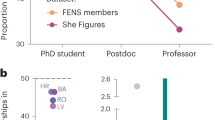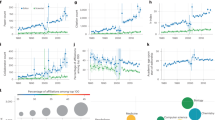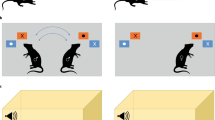Abstract
We reviewed publicly available information from the top 50 journals worldwide in psychology and neuroscience to infer the proportions of editors by gender and country of affiliation. In both fields, the proportions of male and female editors differed significantly, both across editorial roles and within various role categories. Moreover, for 76% of psychology journals and 88% of neuroscience journals more than 50% of editors were male, whereas only 20% and 10%, respectively, had a similar proportion of female editors. US-based academics outnumbered those from other countries as editors in both psychology and neuroscience beyond what would be expected from approximate rates of senior psychology and neuroscience scholars worldwide. Our findings suggest that editorial positions in academic journals—possibly one of the most powerful decision-making roles in academic psychology and neuroscience—are balanced in neither gender nor geographical representation.
This is a preview of subscription content, access via your institution
Access options
Access Nature and 54 other Nature Portfolio journals
Get Nature+, our best-value online-access subscription
$32.99 / 30 days
cancel any time
Subscribe to this journal
Receive 12 print issues and online access
$259.00 per year
only $21.58 per issue
Buy this article
- Purchase on SpringerLink
- Instant access to full article PDF
Prices may be subject to local taxes which are calculated during checkout



Similar content being viewed by others
Reference
Gruber, J. et al. The future of women in psychological science. Perspect. Psychol. Sci. 16, 483–516 (2020).
Roberts, S. O., Bareket-Shavit, C., Dollins, F. A., Goldie, P. D. & Mortenson, E. Racial inequality in psychological research: trends of the past and recommendations for the future. Perspect. Psychol. Sci. 15, 1295–1309 (2020).
Ryu, M. Minorities in Higher Education: Twenty-fourth Status Report (American Council on Education, 2010).
Llorens, A. et al. Gender bias in academia: a lifetime problem that needs solutions. Neuron 109, 2047–2074 (2021).
Fowler, G. et al. Women outnumber men in psychology graduate programs. Monitor on Psychol. 49, 21 (2018).
Stricker, E. M. The 2003 ANDP Survey of Neuroscience Graduate, Postdoctoral, and Undergraduate Programs (Association of Neuroscience Departments and Programs, 2003).
Webber, K. L. & González Canché, M. Is there a gendered path to tenure? A multi-state approach to examine the academic trajectories of US doctoral recipients in the sciences. Res. High. Educ. 59, 897–932 (2018).
Ginther, D. & Kahn, S. in The Economics of Economists: Institutional Setting, Individual Incentives and Future Prospects (eds. A. Lanteri et al.) 285–315 (Cambridge Univ. Press, 2014).
National Research Council. Gender Differences in Critical Transitions in the Careers of Science, Engineering, and Mathematics Faculty (The National Academies Press, 2010).
Williams, W. M. & Ceci, S. J. National hiring experiments reveal 2:1 faculty preference for women on STEM tenure track. Proc. Natl Acad. Sci. USA 112, 5360–5365 (2015).
National Science Foundation, National Center for Science and Engineering Statistics. Doctorate Recipients from US Universities: 2017 (Special Report NSF 19-301), https://ncses.nsf.gov/pubs/nsf19301 (2018).
Eagly, A. H. & Miller, D. I. Scientific eminence: where are the women? Perspect. Psychol. Sci. 11, 899–904 (2016).
Amrein, K., Langmann, A., Fahrleitner-Pammer, A., Pieber, T. R. & Zollner-Schwetz, I. Women underrepresented on editorial boards of 60 major medical journals. Gend. Med. 8, 378–387 (2011).
Hafeez, D. M. et al. Gender distribution in psychiatry journals’ editorial boards worldwide. Compr. Psychiatry 94, 152119 (2019).
Mariotto, S., Beatrice, G., Carta, S., Bozzetti, S. & Mantovani, A. Gender disparity in editorial boards of journals in neurology. Neurology 95, 489–491 (2020).
Dworkin, J., Perry, Z. & Bassett, D. S. (In)citing action to realize an equitable future. Neuron 106, 890–894 (2020).
Weick, K. E. in Publishing in the Organizational Sciences (eds Cummings, L. L. & Frost, P. J.) 284–296 (Sage, 1995).
Baruch, Y. Global or North American? a geographical-based comparative analysis of publications in top management journals. Int. J. Cross. Cult. Manag. 1, 109–126 (2001).
Granadino, B., García-Carpintero, E. & Plaza, L. M. La presencia española en consejos y comites deredaccion de revistas científicas internacionales: un instrumento para la promoción de nuestra ciencia [in Spanish]. Revista Española de Documentación Científica 29, 398–408 (2006).
García-Carpintero, E., Granadino, B. & Plaza, L. The representation of nationalities on the editorial boards of international journals and the promotion of the scientific output of the same countries. Scientometrics 84, 799–811 (2010).
Elson, M., Huff, M. & Utz, S. Metascience on peer review: testing the effects of a study’s originality and statistical significance in a field experiment. Adv. Methods Pract. Psychol. Sci. 3, 53–65 (2020).
John, L. K., Loewenstein, G. & Prelec, D. Measuring the prevalence of questionable research practices with incentives for truth telling. Psychol. Sci. 23, 524–532 (2012).
Pritschet, L., Powell, D. & Horne, Z. Marginally significant effects as evidence for hypotheses: changing attitudes over four decades. Psychol. Sci. 27, 1036–1042 (2016).
Simmons, J. P., Nelson, L. D. & Simonsohn, U. False-positive psychology: undisclosed flexibility in data collection and analysis allows presenting anything as significant. Psychol. Sci. 22, 1359–1366 (2011).
Markus, H. R. & Kitayama, S. Culture and the self: implications for cognition, emotion and motivation. Psychol. Rev. 98, 224 (1991).
Molenberghs, P. The neuroscience of in-group bias. Neurosci. Biobehav. Rev. 37, 1530–1536 (2013).
Bourke, B. Positionality: reflecting on the research process. Qual. Rep. 19, 1–9 (2014).
Medin, D. L. & Bang, M. Who’s Asking? Native Science, Western Science and Science Education (MIT Press, 2014).
Medin, D., Ojalehto, B., Marin, A. & Bang, M. Systems of (non-)diversity. Nat. Hum. Behav. 1, 1–5 (2017).
Promoting diversity in neuroscience. Nat. Neurosci. 21, 1 https://doi.org/10.1038/s41593-017-0052-6 (2018).
Ceci, S. J., Ginther, D. K., Kahn, S. & Williams, W. M. Women in academic science: a changing landscape. Psychol. Sci. Public Interest 15, 75–141 (2014).
Murray, D. et al. Author–reviewer homophily in peer review. Preprint at https://doi.org/10.1101/400515v3.full (2019).
National Center for Science and Engineering Statistics. Women, Minorities, and Persons with Disabilities in Science and Engineering, https://ncses.nsf.gov/pubs/nsf19304 (National Science Foundation, 2019).
De Kleijn, M. et al. The Researcher Journey Through a Gender Lens: An Examination of Research Participation, Career Progression and Perceptions Across the Globe, www.elsevier.com/gender-report (Elsevier, 2020).
Biaswatchneuro. Neuroscience base rates, https://biaswatchneuro.com/base-rates/neuroscience-base-rates/ (2020).
Wing, D. A., Benner, R. S., Petersen, R., Newcomb, R. & Scott, J. R. Differences in editorial board reviewer behavior based on gender. J. Womens Health 19, 1919–1923 (2010).
Murphy, M. C., Steele, C. M. & Gross, J. J. Signaling threat: how situational cues affect women in math, science and engineering settings. Psychol. Sci. 18, 879–885 (2007).
American Psychological Association, Committee on Women in Psychology. The Changing Gender Composition of Psychology: Update and Expansion of the 1995 Task Force Report, http://www.apa.org/pi/women/programs/gender-composition/task-force-report.pdf (2017).
Geiger, A. W., Livingston, G. & Bialik, K. Six Facts about US Moms (Analysis of American Time Use Survey Data), https://www.pewresearch.org/fact-tank/2019/05/08/facts-about-u-s-mothers/ (2019).
Sege, R., Nykiel-Bub, L. & Selk, S. Sex differences in institutional support for junior biomedical researchers. JAMA 314, 1175–1177 (2015).
Acton, S. E., Bell, A. J. D., Toseland, C. P. & Twelvetrees, A. Research culture: a survey of new PIs in the UK. eLife 8, e46827 (2019).
Ragins, B. R. & Cotton, J. L. Gender and willingness to mentor in organizations. J. Manag. 19, 97–111 (1993).
Mitchell, S. M. & Hesli, V. L. Women don’t ask? women don’t say no? bargaining and service in the political science profession. Political Sci. Politics 46, 355–369 (2013).
Xie, Y. & K. A. Shauman. Women in Science: Career Processes and Outcomes (Harvard Univ. Press, 2003).
Cole, E. R. Intersectionality and research in psychology. Am. Psychol. 64, 170 (2009).
Yoder, J. B. & Mattheis, A. Queer in STEM: workplace experiences reported in a national survey of LGBTQA individuals in science, technology, engineering, and mathematics careers. J. Homosex. 63, 1–27 (2016).
Knobloch-Westerwick, S., Glynn, C. J. & Huge, M. The Matilda effect in science communication: an experiment on gender bias in publication quality perceptions and collaboration interest. Sci. Commun. 35, 603–625 (2013).
Marts, S. Open secrets and missing stairs: sexual and gender-based harassment at scientific meetings, https://doi.org/10.13140/RG.2.2.14861.3376 (2017).
Schroeder, J. et al. Fewer invited talks by women in evolutionary biology symposia. J. Evol. Biol. 26, 2063–2069 (2013).
Bendels, M. H. K., Müller, R., Brueggmann, D. & Groneberg, D. A. Gender disparities in high-quality research revealed by Nature Index journals. PLoS ONE 13, e0189136 (2013).
Acknowledgements
This study was supported by a University of California San Francisco Weill Institute Women in Neurosciences RFA for Research Support for Female Learners Impacted by coronavirus disease 2019, awarded to E.R.P. This study and A.F.’s time were supported by the Faculty of Brain Sciences, University College London. We thank M. Tsakiris and M. Patrick for their comments on earlier versions of this paper, and the many editors who provided their comments about the findings.
Author information
Authors and Affiliations
Contributions
E.R.P.: conceptualization, methodology, investigation, formal analysis, data curation, writing—original draft, writing—review & editing, visualization, project administration and funding acquisition. M.L.: conceptualization, methodology, investigation, data curation, writing—review & editing. A.F.: conceptualization, methodology, resources, writing—review & editing, supervision, project administration and funding acquisition.
Corresponding author
Ethics declarations
Competing interests
The authors declare no competing interests.
Peer review
Peer review information
Nature Neuroscience thanks Carmen Sandi, Cassidy Sugimoto, and the other, anonymous, reviewer(s) for their contribution to the peer review of this work.
Additional information
Publisher’s note Springer Nature remains neutral with regard to jurisdictional claims in published maps and institutional affiliations.
Supplementary information
Supplementary Information
Supplementary Tables 1–3, Supplementary Figs. 1 and 2 and Supplementary analysis
Supplementary Data 1
Tabulated data for editorial boards of the top 50 psychology journals.
Supplementary Data 2
Tabulated data for editorial boards of the top 50 neuroscience journals.
Rights and permissions
About this article
Cite this article
Palser, E.R., Lazerwitz, M. & Fotopoulou, A. Gender and geographical disparity in editorial boards of journals in psychology and neuroscience. Nat Neurosci 25, 272–279 (2022). https://doi.org/10.1038/s41593-022-01012-w
Received:
Accepted:
Published:
Issue date:
DOI: https://doi.org/10.1038/s41593-022-01012-w
This article is cited by
-
Repräsentation von Frauen in leitenden Positionen der Akut- und Notfallmedizin
Medizinische Klinik - Intensivmedizin und Notfallmedizin (2025)
-
Editorial Boards of Finance Journals: The Gender Gap and Social Networks
Journal of Business Ethics (2025)
-
Psychology needs more diversity at the level of Editor-in-Chief
Communications Psychology (2024)
-
Mapping science through editorial board interlocking: connections and distance between fields of knowledge and institutional affiliations
Scientometrics (2024)
-
Sustainable scientific publishing: a pilot survey on stakeholder motivations and opinions
Discover Sustainability (2024)



